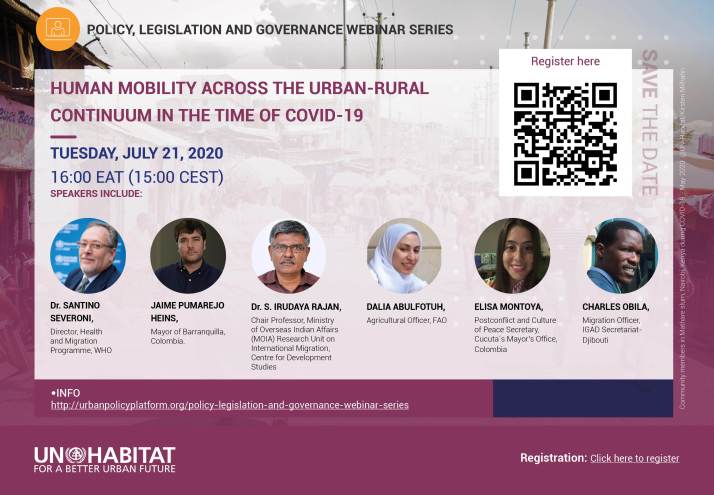21 July, from 16:00 to 17:30 East Africa Time (EAT)
This webinar is part of a series of webinars (PLG Webinar Series and URL Webinar Series) that aim to contribute to the thinking processes on integrated territorial development and increase understanding how the impacts of Covid-19 can advance opportunities to reorient policies and development practices and to catalyze territorial approaches and promote transformative change. Together with relevant partners, we aim to co-develop a deeper understanding and exchange on how stronger urban-rural linkages and other territorial approaches – such as food systems, landscape and ecosystem approaches – can become an integral part of the Covid-19 recovery responses and global long-term sustainable actions.
Click here to find the agenda and more information on the webinar.

Duty Station: Regional IFAD office in East and Southern Africa
Deadline for application: 18 March 2021
Tuesday, July 14, 2020 - 10:00 am to 11:30 am (EDT)
The 2020 State of Food Security and Nutrition in the World (SOFI) report highlights the most recent and authoritative estimates of the extent of hunger, food insecurity and malnutrition around the world. The Report calls for a transformative change in food systems to ensure healthy and affordable diets for all, a sine qua non for eliminating hunger and malnutrition.
As the 2030 deadline looms, SOFI 2020 gauges whether #ZeroHunger remains achievable by tracking countries' performance and trajectory to offer a tiered assessment of the likelihood of success.
Join this high-level discussion co-organized by FAO North America and IFPRI with distinguished speakers, including Members of the US Congress and the Directors-General of FAO and IFPRI, on the report’s key findings as well as the potential impact of the COVID-19 pandemic on global food and nutrition security.
Updates for many countries have made it possible to estimate hunger in the world with greater accuracy this year. In particular, newly accessible data enabled the revision of the entire series of undernourishment estimates for China back to 2000, resulting in a substantial downward shift of the series of the number of undernourished in the world. Nevertheless, the revision confirms the trend reported in past editions: the number of people affected by hunger globally has been slowly on the rise since 2014. The report also shows that the burden of malnutrition in all its forms continues to be a challenge. There has been some progress for child stunting, low birthweight and exclusive breastfeeding, but at a pace that is still too slow. Childhood overweight is not improving and adult obesity is on the rise in all regions.
The report complements the usual assessment of food security and nutrition with projections of what the world may look like in 2030, if trends of the last decade continue. Projections show that the world is not on track to achieve Zero Hunger by 2030 and, despite some progress, most indicators are also not on track to meet global nutrition targets. The food security and nutritional status of the most vulnerable population groups is likely to deteriorate further due to the health and socio economic impacts of the COVID-19 pandemic.
The report puts a spotlight on diet quality as a critical link between food security and nutrition. Meeting SDG 2 targets will only be possible if people have enough food to eat and if what they are eating is nutritious and affordable. The report also introduces new analysis of the cost and affordability of healthy diets around the world, by region and in different development contexts. It presents valuations of the health and climate-change costs associated with current food consumption patterns, as well as the potential cost savings if food consumption patterns were to shift towards healthy diets that include sustainability considerations. The report then concludes with a discussion of the policies and strategies to transform food systems to ensure affordable healthy diets, as part of the required efforts to end both hunger and all forms of malnutrition.
Read online the full digital report
See the interactive story
Read the In Brief
Latest Pics
 SUN Country MeetingApril 30, 2019 - 1:28 pm
SUN Country MeetingApril 30, 2019 - 1:28 pm SUN Global MeetingApril 12, 2019 - 11:26 am
SUN Global MeetingApril 12, 2019 - 11:26 am ZimVAC Kariba WorkshopDecember 20, 2018 - 9:02 am
ZimVAC Kariba WorkshopDecember 20, 2018 - 9:02 am World Food Day 2018December 19, 2018 - 5:44 pm
World Food Day 2018December 19, 2018 - 5:44 pm Chipinge Food FairDecember 19, 2018 - 8:47 am
Chipinge Food FairDecember 19, 2018 - 8:47 am
World News
 Mock, sample post 3July 16, 2024 - 6:14 pm
Mock, sample post 3July 16, 2024 - 6:14 pm Mock, sample post 2July 16, 2024 - 6:11 pm
Mock, sample post 2July 16, 2024 - 6:11 pm
News Calendar
| M | T | W | T | F | S | S |
|---|---|---|---|---|---|---|
| 1 | 2 | 3 | 4 | 5 | 6 | 7 |
| 8 | 9 | 10 | 11 | 12 | 13 | 14 |
| 15 | 16 | 17 | 18 | 19 | 20 | 21 |
| 22 | 23 | 24 | 25 | 26 | 27 | 28 |
| 29 | 30 | 31 | ||||
Contact Us!
Tel: +263 242 860 327
1574 Alpes Road
Harare
Zimbabwe
Email: info@fnc.org.zw
- Monday-Friday: 8am to 4:30pm
- Saturday: Closed
- Sunday: Closed

